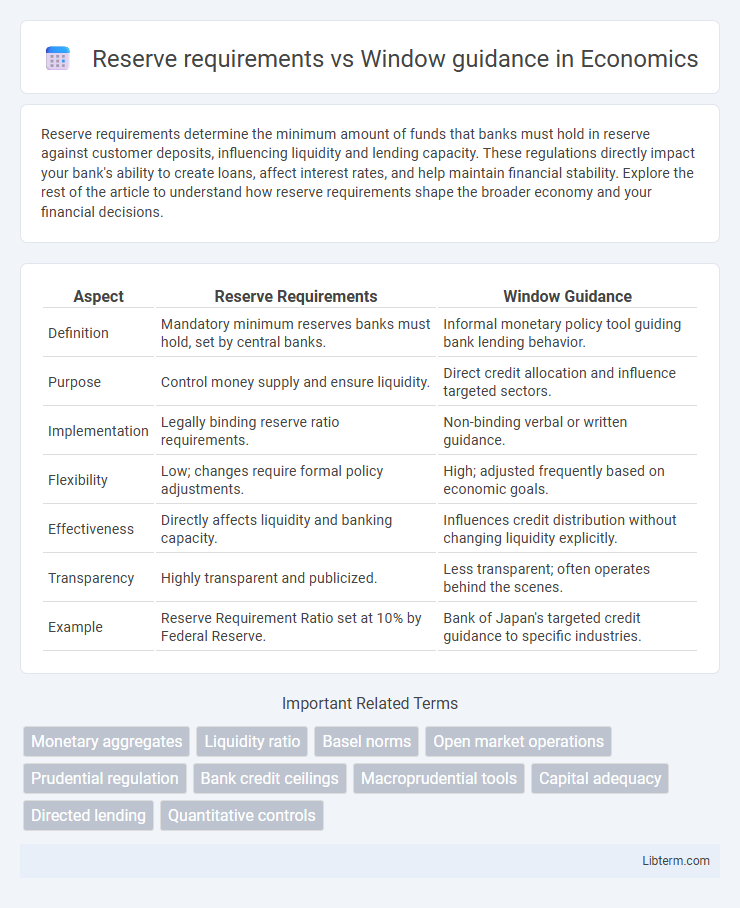Reserve requirements determine the minimum amount of funds that banks must hold in reserve against customer deposits, influencing liquidity and lending capacity. These regulations directly impact your bank's ability to create loans, affect interest rates, and help maintain financial stability. Explore the rest of the article to understand how reserve requirements shape the broader economy and your financial decisions.
Table of Comparison
| Aspect | Reserve Requirements | Window Guidance |
|---|---|---|
| Definition | Mandatory minimum reserves banks must hold, set by central banks. | Informal monetary policy tool guiding bank lending behavior. |
| Purpose | Control money supply and ensure liquidity. | Direct credit allocation and influence targeted sectors. |
| Implementation | Legally binding reserve ratio requirements. | Non-binding verbal or written guidance. |
| Flexibility | Low; changes require formal policy adjustments. | High; adjusted frequently based on economic goals. |
| Effectiveness | Directly affects liquidity and banking capacity. | Influences credit distribution without changing liquidity explicitly. |
| Transparency | Highly transparent and publicized. | Less transparent; often operates behind the scenes. |
| Example | Reserve Requirement Ratio set at 10% by Federal Reserve. | Bank of Japan's targeted credit guidance to specific industries. |
Introduction to Reserve Requirements and Window Guidance
Reserve requirements mandate banks to hold a specific fraction of customer deposits as reserves, ensuring liquidity and financial stability. Window guidance refers to informal directives from central banks guiding lending behaviors without formal regulations. Both tools influence credit availability, with reserve requirements providing a quantitative constraint and window guidance offering qualitative supervisory control.
Historical Evolution of Monetary Policy Tools
Reserve requirements, initially established in the early 20th century, forced banks to hold a specific percentage of deposits as reserves, directly controlling money supply and liquidity. Window guidance, developed in the post-war era, especially in East Asian economies like Japan and South Korea, introduced a qualitative approach where central banks influenced credit allocation through informal directives rather than rigid numerical targets. The historical evolution reflects a shift from quantitative constraints of reserve requirements to more flexible, targeted credit control via window guidance, adapting to changing financial systems and economic priorities.
Defining Reserve Requirements
Reserve requirements mandate the minimum amount of funds that banks must hold in reserve against deposits, ensuring liquidity and financial stability in the banking system. These regulatory tools directly influence money supply by restricting the volume of loans banks can issue, impacting credit creation and economic activity. Reserve requirements differ from window guidance, which provides discretionary lending limits set by central banks to guide credit growth more flexibly.
Understanding Window Guidance
Window guidance is a monetary policy tool used primarily by central banks, especially in East Asia, to direct financial institutions on lending behaviors without explicit market transactions or formal regulations. Unlike reserve requirements, which mandate a specific fraction of deposits to be held as reserves, window guidance involves informal quotas or targets for lending to particular sectors or projects, enabling targeted economic stimulus or restraint. This approach provides flexibility and discretion, allowing policymakers to influence credit allocation proactively while avoiding some limitations of rigid reserve mandates.
Mechanisms: How Reserve Requirements Operate
Reserve requirements mandate banks to hold a specific percentage of their deposit liabilities as non-interest-bearing reserves at the central bank, effectively controlling the amount of funds available for lending and influencing money supply. This mechanism ensures liquidity stability by restricting excessive credit expansion and acting as a buffer against bank runs. Reserve requirements directly impact monetary policy transmission by adjusting the base money creation capacity within the banking system.
Mechanisms: How Window Guidance Works
Window guidance operates through direct instructions from central banks to commercial banks, guiding credit allocation to targeted sectors by setting lending quotas or growth ceilings. Unlike reserve requirements, which mandate the minimum reserves banks must hold, window guidance influences lending behavior without altering liquidity levels directly. This mechanism relies on regulatory oversight and negotiations, enabling central banks to steer credit expansion towards priority areas while maintaining financial stability.
Comparative Effectiveness in Credit Control
Reserve requirements mandate banks to hold a fixed portion of deposits as reserves, directly limiting their capacity to extend loans, thereby offering precise control over money supply. Window guidance involves regulatory directives encouraging banks to restrict or expand credit based on economic objectives, providing flexibility and qualitative influence over lending behaviors. Comparative studies indicate reserve requirements deliver immediate quantitative constraints, while window guidance adapts to economic conditions but depends on banks' compliance and regulatory enforcement effectiveness.
Advantages and Limitations of Reserve Requirements
Reserve requirements mandate banks to hold a fixed percentage of deposits as reserve, ensuring liquidity and reducing credit risk, which enhances financial stability. However, this tool lacks flexibility, can be blunt in controlling credit cycles, and may lead to inefficiencies by forcing banks to hold non-earning assets. In contrast, window guidance allows for targeted credit allocation but depends heavily on regulatory discretion and can be less transparent.
Benefits and Drawbacks of Window Guidance
Window guidance allows central banks to provide direct, flexible credit allocation targets to financial institutions, enabling targeted support for key sectors and enhanced control over credit growth. This approach improves the precision of monetary policy implementation but may reduce market transparency and increase the risk of regulatory arbitrariness. Unlike rigid reserve requirements, window guidance offers adaptability but can create uncertainties for banks regarding compliance and long-term planning.
Contemporary Relevance and Future Outlook
Reserve requirements remain a crucial monetary policy tool for central banks to control liquidity by mandating minimum reserves banks must hold, directly influencing credit availability and financial stability. Window guidance, primarily used in East Asian economies like China, provides qualitative direction to banks on lending practices, allowing for more flexible and targeted credit allocation aligned with national economic goals. With rising financial innovation and digital currencies, reserve requirements face challenges in effectiveness, while window guidance's adaptive approach may expand to address evolving market complexities and sustainable development priorities.
Reserve requirements Infographic

 libterm.com
libterm.com